
"Paintings by Stanley Roseman glow with a shiny dignity"
- The New York Times
Spirit of the Clown
''These are clown portraits that look behind the greasepaint.''
STANLEY ROSEMAN
SPIRIT of the CLOWN
Clown Alley
In a rare acceptance of a circus outsider, Roseman was given the unique privilege to draw and to paint portraits of the clowns in the private backstage area appropriated for the clowns' dressing room, called in circus terminology ''Clown Alley,'' a legendary place within the circus world. The Director of Clowns provided Roseman with his own place to set up his easel and canvases in Clown Alley, the first of such working spaces he was given in his sojourns with the circus over the years.
Empathy with his Models
2. Frosty Little, 1977
Oil on Strathmore paper, 73 x 58 cm
Musée des Beaux-Arts, Bordeaux
Oil on Strathmore paper, 73 x 58 cm
Musée des Beaux-Arts, Bordeaux
The New York Times cites Roseman's empathy with his models and praises the artist for his technical virtuosity: "Roseman's style is particularly congenial to the subject matter. His vigorous brushstrokes, bold compositions silhouetted against summary backgrounds and his prodigiously bright colors are consistent with the gaiety and fantasy we associate with circus clowns.''
The Musée des Beaux-Arts, Bordeaux, conserves in its prestigious collection the superb portrait Frosty Little, 1977, (fig. 2). Roseman depicts the esteemed Director of Clowns in a quiet interlude between the busy backstage activity of preparing for a show and the heightened energy of a performance in the arena.
3. Stanley Roseman drawing the memorable clowns Bruce Gutilla (left) and Dale Longmire
in a backstage area at the
Ringling Bros. and Barnum & Bailey Circus,
Madison Square Garden, New York City, 1977.
in a backstage area at the
Ringling Bros. and Barnum & Bailey Circus,
Madison Square Garden, New York City, 1977.
NBC Television News aired on its evening broadcast an enthusiastic reportage of Roseman at the Ringling Bros. and Barnum & Bailey Circus, Madison Square Garden, and stated:
At the Ringling Bros. and Barnum & Bailey Circus
The NBC broadcast included an interview with Roseman in the Main Gallery of the Lincoln Center Museum, where were exhibited a hundred works on paper and the artist's life-size paintings of the circus clowns.
NBC News announced the exhibition Stanley Roseman - The Performing Arts in America, which had toured the United States for the American bicentennial from December of 1975 through 1976 and was concluding its national tour at the Library and Museum for the Performing Arts, Lincoln Center, winter-spring 1977. The one-man exhibition comprised the artist's drawings created at dress rehearsals and performances of opera, theatre, and dance and his work on the subject of the circus clown. (See "Biography" - Page 2 "The Performing Arts in America Exhibition.")
Continuing Inspiration from the Circus Clowns
''a stunning series of engravings entitled 'Clowns' ''
- The Times, London
On the Road with the Ringling Bros. and Barnum & Bailey Circus
When Roseman sojourned with the circus in 1976 in Washington, D.C., and in Hartford, Connecticut, one of the artist's engaging models was a recent inhabitant of Clown Alley, a white-face clown named George, with pensive, dark eyes and cheeks painted with bright red circles that complemented his white, ball-of-a nose, adorned with a small glittering "diamond.''
4. George, 1976
Oil on Strathmore paper, 73 x 58 cm
Victoria and Albert Museum, London
Oil on Strathmore paper, 73 x 58 cm
Victoria and Albert Museum, London
When George arrived at the Victoria and Albert Museum in 1985, the painting was greeted with much enthusiasm. The eminent curator Dr. Alexander Schouvaloff writes in a gracious letter:
"George arrived in perfect condition. It was truly exciting to open the package and a delight
to finally see the portrait. We are thrilled to have the painting in our collection."
to finally see the portrait. We are thrilled to have the painting in our collection."
- Dr. Alexander Schouvaloff
Senior Curator
Victoria and Albert Museum, London
Senior Curator
Victoria and Albert Museum, London
The clowns offered Roseman their time in the intervals between their acts, during intermissions, and before and after the shows. Tommy Adams, whose friendly personality delighted circus audiences, was the first to model for the artist in Clown Alley. The young clown, wearing a red plaid shirt, brown hat, and beige trousers, stands with a pensive expression under his white-face makeup with a painted red smile in the superb oil on canvas portrait Tommy Adams, 1973, (Private collection, Michigan). The auguste clown and dwarf Jimmy Briscoe augmented his small stature by his commanding presence in the circus ring. Jimmy, with red nose and painted freckles on his rouged cheeks, is costumed in a colorfully patched, turquoise suit and green top hat as he looks out from the canvas in Roseman's excellent portrait Jimmy Briscoe, 1973, (Private collection, Switzerland).
Taking up his sculpting tools and clay, Roseman sculpted in 1978 a life-size bust of King Richard wearing a high top hat and Elizabethan ruff. In an article on Roseman's work on the circus clown, Anzeiger von Saanen, Gstaad, praises the ''superb portrait sculpture in bronze of King Richard.'' The edition of the sculpture King Richard comprises eight signed and numbered bronzes, (Private collections, United States and Switzerland).
The beautiful portrait Peggy Williams, (fig. 9), depicts the charming clownesse in profile, a feather boa around her shoulders. Peggy's lovely face with delicate clown makeup and her upswept hair are framed by the oval of her large, fin de siècle hat, with an abundance of plumes subtly expressed by the fine, feathery burrs from the incised, drypoint lines.
''Clowns, I believe, must be as difficult to characterize in paintings as they are in words, for their art defies analytical conventions and descriptions. Although their skills remain firmly fixed in our minds, their interpretations have the gossamer evanescence of filigree. And yet Roseman has managed to catch the spirit of the clown. . . .''
Enamored of the circus and the clowns from his childhood, Roseman enthusiastically returned to the circus in his professional career with a cordial invitation from the Ringling Bros. and Barnum & Bailey Circus. What began with a series of drawings of the celebrated clowns for three exciting weeks at Madison Square Garden, New York City, in the spring of 1973, became a major theme in Roseman's oeuvre and a critically acclaimed work on the subject of the clown.
Roseman's work earned him great respect from the circus clowns, and his modesty and pleasant manner established lasting friendships in the closed and itinerant circus community.
- NBC Television News
© Stanley Roseman and Ronald Davis - All Rights Reserved
Visual imagery and website content may not be reproduced in any form whatsoever.
Visual imagery and website content may not be reproduced in any form whatsoever.
Keith Crary (detail), 1973,
as featured in The New York Times review
"Spirit of the Clown" and subtitled
"Paintings by Stanley Roseman glow with a shiny dignity"
as featured in The New York Times review
"Spirit of the Clown" and subtitled
"Paintings by Stanley Roseman glow with a shiny dignity"
SPIRIT of the CLOWN continues
with a link at the bottom of this page
to SPIRIT of the CLOWN - PARIS
with a link at the bottom of this page
to SPIRIT of the CLOWN - PARIS
The pyramidal composition of the painting is restated in the triangular leitmotif of the boat-like hat on the clown's "bald" head, the shapes of his collar and jacket, and the light-blue makeup that descends from the corner of his eyes onto his cheeks. The red on his lower lip and on the tip of his nose add bright accents to the beautiful painting.
In its review The New York Times observes the humanism in Roseman's depictions of the Clown, who "has chosen his profession and carries it out not only with artistry but with a shiny dignity. . . . But he is also described in those moments of introspection. . . ."
The New York Times states that Roseman's skillful rendering with oil paint on canvas or paper "underscores the fragility of the clowns' impressions. One can sense that their mood might change instantaneously and remove us to another dream world.''
A warm tonal harmony of yellow ochre, orange, lilac, and sienna pervades the painting. Roseman's expressive brushstrokes defining the pictorial space and describing the circus clown's costume are complemented by the fine modeling of the facial features and the subtle tones of the clown's white-face makeup.
5. Ruth, (detail), 1976
Oil on canvas, 128 x 90 cm
Private collection, Switzerland
Oil on canvas, 128 x 90 cm
Private collection, Switzerland
The Paintings
The New York Times review ''Spirit of the Clown'' was greeted with excitement at Western Electric, as that was the first time an exhibition at the Corporate Education Center had been reviewed by the eminent daily. The New York Times praises ''this exhibition effectively organized by Ronald Davis'' and subtitles its review: ''Paintings by Stanley Roseman glow with a shiny dignity.''
6. Keith Crary (detail), 1973
Oil on canvas, tondo, 60 cm
Private collection
Oil on canvas, tondo, 60 cm
Private collection
''In the Face of the Clown You See his Soul.''
- Aftonbladet, Stockholm
Featured in The New York Times review is the superb portrait of the young circus clown Keith Crary, (fig. 6). The clown in beautiful, white-face makeup, with a broad, black, painted smile; small red nose; and ample tufts of blue hair on the sides of his head, is fashionably attired in a white shirt, dark jacket with red lapels, and a burgundy bow tie. With complementary warm shadows and brilliant white highlights, Roseman has masterly rendered the face of the young clown who with sympathetic eyes offers the viewer a friendly regard.
When The Performing Arts in America exhibition was at the Library and Museum for the Performing Arts at Lincoln Center, Roseman received an invitation from the executive administration of the Engineering Research Center of Western Electric, a division of American Telephone and Telegraph (AT&T) in Princeton, New Jersey, to mount an exhibition in the Corporate Education Center's galleries at its campus in the neighboring town of Hopewell. Roseman was appreciative of the invitation as he had earned his Bachelor of Fine Arts degree from the Cooper Union for the Advancement of Science and Art, the prestigious New York City college that combines the three disciplines of art, architecture, and engineering in a single institution of higher learning.
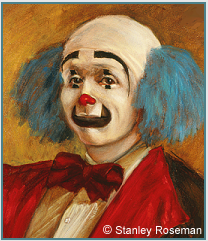
8. Lou Jacobs, 1976
Drypoint, 25.5 x 20.5 cm
Collections: Victoria and Albert Museum, London
Bibliothèque Nationale de France, Paris
Library and Museum for the Performing Arts, Lincoln Center, New York City
Drypoint, 25.5 x 20.5 cm
Collections: Victoria and Albert Museum, London
Bibliothèque Nationale de France, Paris
Library and Museum for the Performing Arts, Lincoln Center, New York City
The Ringling Bros. and Barnum & Bailey Circus, also known as ''The Greatest Show on Earth,'' traveled annually in those days on its own lengthy circus train and performed in three rings in amphitheaters throughout the United States. The Director of Clowns, Glen ''Frosty'' Little, corresponded with his new friend in the months following the circus's spring engagement in New York City. Encouraged by the clowns to join them on the road and to bring his painting materials, Roseman traveled in October of 1973 to Chicago, where the famous American circus played the Chicago Amphitheater.
In Washington, D.C., and Troy, New York, in 1976, Roseman created impressive paintings of Bruce and Dale, who are seen with the artist in the photograph above, (fig. 3), from the NBC Television News broadcast.
With fine chiaroscuro modeling Roseman renders the expressive face of the clown. The warm tones of a pearly-gray background are applied with a freedom of brushwork. The portrait George joins the Museum's renowned collection devoted to the performing arts.
At Philadelphia's Spectrum amphitheater in 1977, Roseman did an engaging portrait of a white-face clown called Chino, with a large red nose and orange hair, (Private collection, New York City), as well as a suite of fine pencil drawings of the clowns in performance and in Clown Alley. That same year Roseman resumed painting and drawing the clowns in the familiar backstage environment of Madison Square Garden, where he had first begun his work at the Ringling Bros. and Barnum & Bailey Circus.
Newspapers, magazines, and journals have featured Roseman's clowns and praised the artist's work on a variety of subjects and themes. Aftonbladet, Stockholm, published in 1980 in its Sunday magazine a cover story on the artist and presented on the cover the portrait Keith Crary. In the enthusiastic reportage entitled "In the Face of the Clown You See his Soul," Sweden's leading daily commends Roseman for his approach to his art: "He lives together with groups of people he wants to portray, seeks their inner self.'' Aftonbladet praises Roseman's work "on a high artistic level as well as accurately expressive of the human dimension.''
The leading Spanish newspaper Ya, Madrid, also published a cover story on the artist for its Sunday magazine and presented Roseman's Frosty Little on the cover. Reproduced in the magazine's double page centerfold were twelve of the artist's paintings and drawings, including the portraits King Richard and Bruce Gutilla.
The Journal of the American Medical Association, JAMA, reproduced on the cover of the July 3rd issue, 1981, Roseman's portrait Frosty Little, the Journal's early use of contemporary art on its covers. The following year, the portrait of the celebrated circus clown was also reproduced on the cover of the Japanese edition of JAMA.
Booklist, the journal of the American Library Association, reproduced Roseman's double portrait Dale Longmire on the magazine's cover. Among other publications that presented Roseman's paintings of circus clowns and in feature stories on the artist and his work were the Dutch newsmagazine Nieuwsnet, with the painting of Dale; and the Belgian newsmagazine De Post, with a full-page reproduction of the painting of Mark and Ron, as mentioned above.
7. Cover of JAMA -
Journal of the American Medical Association, 1981,
featuring Roseman's portrait Frosty Little,
collection Musée des Beaux-Arts, Bordeaux.
Journal of the American Medical Association, 1981,
featuring Roseman's portrait Frosty Little,
collection Musée des Beaux-Arts, Bordeaux.
Jack made an appearance at the Paris Opéra in 1996 on the occasion of the gala reopening of the Paris Opéra, Palais Garnier, and Roseman's exhibition of drawings on the dance, presented by the Bibliothèque Nationale de France at its museum the Bibliothèque-Musée de l'Opéra, housed in the Palais Garnier. Enamored of Roseman's work on the subject of the clown, the administration asked to exhibit a painting at the entrance to the galleries and selected the portrait of Jack.
In his journal, Roseman speaks about the opening of the exhibition:
A guest at the opening of the Roseman exhibition writes in the guest book: "Je suis tombée 'en amour' devant le clown.'' ("I have fallen 'in love' with the clown.'') - G. M., Paris
10. Jack, 1981
Oil on canvas, 112 x 92 cm
Collection of the artist
Oil on canvas, 112 x 92 cm
Collection of the artist
"Circus clowns are one of the glittering joys of all of our lives, whether we are young or old. Through their theatrical exaggerations, their madcap gestures and antics, their rubber acrobatics and their mimes, they create a magic world at once filled with captivating innocence as well as with the essence of which life is made. They can reach through our pretensions and postures, bare our masquerades through theirs and, all told, touch our souls.
The New York Times published a superlative review "Spirit of the Clown" dedicated to Roseman's paintings created during sojourns with the Ringling Bros. and Barnum & Bailey Circus. The review begins:
- The New York Times
The celebrated auguste master clown Lou Jacobs is the subject of the drypoint presented here, (fig. 8). The senior member of the clown troupe is seated on a folding chair, his eyes closed, and his hands resting on his lap.
The Clowns suite includes a drypoint of Bobby Kay, whose head and shoulders portrait in profile is based on Roseman's painting of the master clown. Frosty Little is depicted reading a newspaper in Clown Alley, which remained a reserve of the male clowns despite the acceptance of women into the clown troupe. King Richard, Bruce Gutilla, Dale Longmire, and Jimmy Briscoe are also represented in the suite of drypoint engravings.
9. Peggy Williams, 1976
Drypoint, 25.5 x 20.5 cm
Victoria and Albert Museum, London
Bibliothèque Nationale de France, Paris
Library and Museum for the Performing Arts,
Lincoln Center, New York City
Drypoint, 25.5 x 20.5 cm
Victoria and Albert Museum, London
Bibliothèque Nationale de France, Paris
Library and Museum for the Performing Arts,
Lincoln Center, New York City
An edition of Drypoint Engravings
Roseman's oeuvre on the circus clown includes an edition of drypoint engravings. Clowns - Ringling Bros. and Barnum & Bailey Circus, published by Ronald Davis, 1976, presents eight drypoint engravings in an edition of twenty portfolios presented in attractive leather and linen, gold-stamped cases made by the noted bookbinder George Wieck of Moroquain. The edition is dedicated by Roseman to the circus clowns.
The process of drypoint engraving is the most akin to drawing of the intaglio printing techniques: The artist draws directly into the copper or zinc plate with a sharp-pointed metal tool, which leaves minute ridges of metal called ''burr'' to the incised lines that hold the ink when printed. The special, aesthetic quality of drypoint, as well as the technical process limiting the number of impressions, has a great appeal to connoisseurs of prints.
The drypoints were included in The Performing Arts in America exhibition at the Library and Museum for the Performing Arts, Lincoln Center. Following the exhibition, the Museum acquired a portfolio of the Clowns suite. The Victoria and Albert Museum, London; and the Bibliothèque Nationale de France, Paris, also acquired portfolios and included the drypoints in exhibitions in London, 1988-1989, and Paris, 1992, respectively.
Returning to Clown Alley
The Bibliothèque Nationale de France in its exhibition publication Stanley Roseman - Dessins sur la Danse à l'Opéra de Paris, 1996, commends Roseman for his "profound interest in the human condition in portraying different kinds of people, professions, social or artistic groups. With a seriousness that pushes him always further in treating a subject or theme, he continually clarifies and refines, never letting his interest waiver or diminish.''[1]
Returning to the Ringling Bros. and Barnum & Bailey Circus for the company's spring engagement at Madison Square Garden in 1981, Roseman painted "a magnificent oil on canvas portrait of the young clown Charlie,'' as stated by Anzeiger von Saanen, Gstaad, in a reportage on the artist and his work. In the portrait Charlie, (Private collection, Geneva), the tramp clown is an endearing subject with his red nose, painted black stubble-of-a-beard, an abundance of auburn hair, and wearing a tattered brown jacket and baggy trousers.
In his return to Clown Alley Roseman created a suite of impressive chalk drawings of Lou Jacobs, who kindly gave of his time to the artist. "Lou's warm welcome back meant very much to me,'' writes the artist in his journal, "and I was very happy to have the occasion to draw again the celebrated auguste clown.''
"Entering the Museum in the former Emperor's Pavilion in the Palais Garnier, I walked down the steps into the foyer, with its marble walls and classical columns, which leads to the exhibition galleries. Across the foyer, facing the entrance to the galleries, was my painting Jack, set into a large niche, like a proscenium arch, and illuminated by spotlights. In my portrait, Jack wears a bright yellow shirt with voluminous sleeves and a black, silk bow tie, a touch of formal elegance that was especially appropriate for an opening at the Paris Opéra.''
Jack's distinctive makeup, with touches of red and blue; his ample, white skullcap nuanced with colors; and yellow shirt are complemented by umber and sienna tones of the background. Fine chiaroscuro modeling with cool highlights and warm shadows on Jack's face enhances this superb portrait of the young clown in a moment of introspection.
The New York Times, in its review "Spirit of the Clown," states that "Roseman's style is particularly congenial to the subject matter. His vigorous brushstrokes, bold compositions silhouetted against summary backgrounds and prodigiously bright colors. . . " are exemplified by the masterfully rendered portrait Jack.
A new member of the clown troupe, a white-face clown named Jack, is the subject of the three-quarter length oil on canvas portrait, (fig. 10).
Spirit of the Clown continues on the following page: SPIRIT of the CLOWN - PARIS
1. Stanley Roseman - Dessins sur la Danse à l'Opéra de Paris - Drawings on the Dance at the Paris Opéra,
(text in French and English), (Paris: Bibliothèque Nationale de France, 1996), p. 11.
(text in French and English), (Paris: Bibliothèque Nationale de France, 1996), p. 11.

Roseman and Davis donated a portfolio of drypoint engravings Clowns - Ringling Bros. and Barnum & Bailey Circus for Christie's Gala Auction for the benefit of the Metropolitan Opera Association, 1977, in sincere gratitude for the invitation to Roseman to draw at the renowned opera house.
The President of the Metropolitan Opera Association, Frank E. Taplin, Rhodes Scholar and philanthropist in the fields of music, education, and science, wrote the Foreword to the Christie's auction catalogue, which presented prints by Dürer, Whistler, Millet, Chagall, and Roseman.
In a warm letter to Roseman, the eminent President writes:
- Frank E. Taplin, President
Metropolitan Opera Association
Metropolitan Opera Association
''We were so happy to have been the successful bidders on your work at the Metropolitan Opera auction on December 4, and I hope Mrs.Taplin and I will have the pleasure of meeting you soon. All good wishes. Sincerely,"
Although the male clown has traditionally held a prominent place in the circus ring, two young women, Peggy Williams, the subject of Roseman's drypoint engraving, (fig. 9, below), and Ruth Chaddock, seen in the painting, (fig. 5, below), joined the Ringling Bros. and Barnum & Bailey Circus in the 1970's and revived the personage of the female circus clown. Talented and charming performers, Ruth and Peggy were captivating models for Roseman, as the Parisian clownesse Cha-U-Kao had been for Toulouse-Lautrec a century before.
The white-face clowns of the Ringling Bros. and Barnum & Bailey Circus have a tradition of designing distinctive clown makeup, as seen in Roseman's paintings and exemplified here by the portrait Ruth. Ruth designed an attractive makeup that enhanced her oval face. Red crescents adorn her cheeks, and thin, arched eyebrows are drawn high on her forehead. The corners of her eyes are accented with curved black lines. Ruth applied small red circles to the corners of her mouth and outlined the red on her lower lip with a thin black line, as she did to the red on the tip of her nose and the crescents on her cheeks.
In this beautiful portrait, Roseman's fluid brushwork and stipples of blues, silvery-whites, and gold describe Ruth's costume complemented by the artist's fine chiaroscuro modeling of the clown's lovely face in powdery-white makeup. Ruth turns to look out from the canvas and smiles sweetly at the viewer, as she did for the artist painting her portrait.
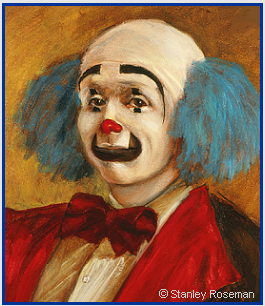
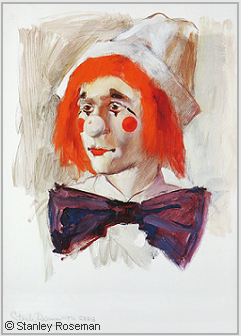
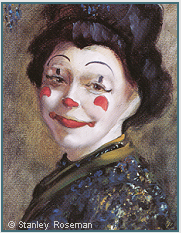
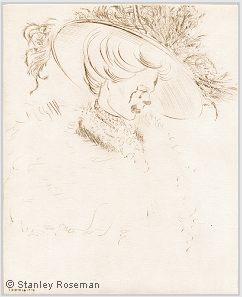
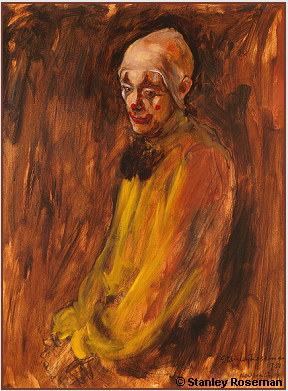
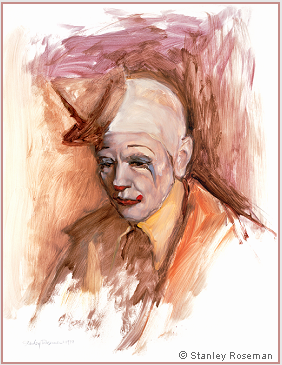
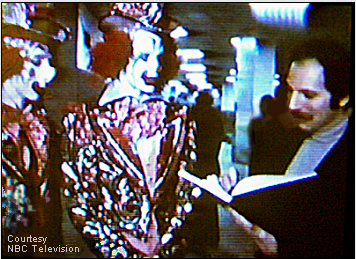
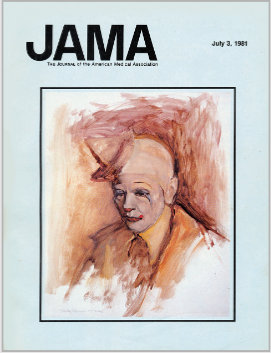
Courtesy of JAMA
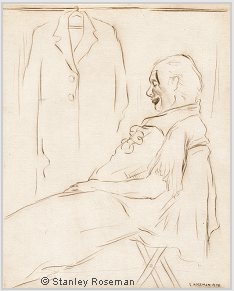
"The clowns of the Garden have invited Stan into their backstage lives as a friend. He has joined the circus family."
The Victoria and Albert Museum, London, conserves the splendid head and shoulders portrait George, presented here, (fig. 4). George is costumed in white like the commedia dell'arte character Gilles, who is depicted in paintings by Watteau, or a modern-day Pierrot, with bright orange hair under his white hat and wearing a large purple bow tie.

- Frosty Little
When the portrait was acquired for the Musée des Beaux-Arts, Bordeaux, in 1984, Frosty writes to say that he is "so proud'' and to thank his friend "so much" for having painted "the beautiful, beautiful picture.''
In letter to Roseman, 1979, Frosty Little writes about his portrait: "That is such an excellent painting. . . . I think it is one of your best and not just because it's me.''
The celebrated circus clown writes to the artist in 1981: "I have to thank you, Stanley, because you're so talented to paint such a picture.''
A garment is draped over the back of his chair; his coat hangs beside him, like a curtain partitioning his own small space in Clown Alley. Lou Jacobs is seen in a moment of repose, a quiet interlude in the backstage world of the circus, a place that Roseman had come to know well.
Theatre, Circus, and Music Hall
Sojourning with the Circus in 1973 at the Nassau Coliseum, Long Island, Roseman painted the portrait of Keith, (top of the page), and an equally impressive portrait of master clown Bobby Kay, whose distinctive white-face makeup is complemented by a voluminous ruff, (Private collection, Switzerland). The auguste clown Mark, wearing a Harlequinesque costume, and his partner the white-face clown Ron, in striped shirt and blue trousers, appear together in a wonderful painting, (Private collection, England). The tall, elegant clown known as King Richard was a regal subject for the artist's brush in a beautiful painting, (Private collection, New Jersey), and again in 1977 at the Nassau Coliseum, where the artist also painted the portrait of Frosty Little, (fig. 2, above).
Page 4 - Spirit of the Clown
Biography: Page 4